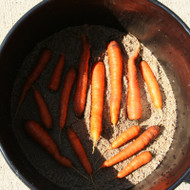Storing fresh vegetables
You have spent the season nurturing your precious crops, fighting off pests and diseases and making sure your fruit and vegetables have the best conditions to live, thrive and survive. Now the moment has arrived to harvest your bounty and if not eaten immediately they will need to be stored properly to keep them at their best. I'm including a few tips to keep your produce in peak condition so you can enjoy the fruits of your labour for the longest time possible.
Carrots, parsnips, celeriac, beetroot, turnip, swede, kohlrabi, horseradish, salsify: These crops all require the same conditions. They usually last well, as most are the storage organs of biennial plants, so would naturally stay dormant in the soil overwinter. Harvest carefully, taking care to avoid skin damage. Do not wash unless grown in very heavy soil or pest/disease damage is suspected. Harvest on a cool day or cool before storage. Remove leaves by twisting off close to crown. Place in layers in shallow crates/boxes separated with a damp packing material such as leaf mould, sand, sieved soil, sawdust (from untreated wood only), or coir. Ideal temperature: 0°- 4°C.Potatoes: Require slightly different conditions from other root crops. They must be kept dark to prevent them turning green and protected from low temperatures. If stored below 5°C the starch turns to sugar, giving them a sweet taste when eaten. Harvest in dry, cool conditions if possible. Remove any damaged tubers; store good ones in thick paper or hessian sacks closed at the neck to conserve moisture. Do not use plastic sacks - the humidity will be too high, which stimulates sprouting. Give extra insulation before weather becomes very cold. Ideal temperature: 5°- 10°C.
Onions/garlic: Lift garlic when only 4-6 outer leaves have turned yellow. Leave onions longer, until the tops have completely died away. Do not bend tops over prematurely. Both need to be dried until skins "rustle", either in the sun or under cover. Store in nets, old tights or make into strings and hang in a cool, dry place where air can circulate.
Ideal temperature: 2°- 4°C.
Pumpkins/winter squash/marrows: Being of sub-tropical origin, these store best at a higher temperature with lower humidity than most other crops. They are very affected by growing conditions, as they need a few weeks of warm sun in August/September to develop a tough skin for successful storage. Harvest before the first frost, leaving as long a stalk as possible. Check for skin blemishes, and store in a dry, airy place, preferably on slatted shelves or hanging in nets.



